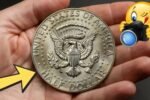Most people barely give a second glance to the pennies jingling in their pockets or collecting dust in a change jar. They’re the smallest unit of U.S. currency, easy to overlook and often dismissed as insignificant. But what if one of those humble coins could be worth thousands—maybe even tens of thousands—of dollars? That’s the reality with the Lincoln Wheat Penny, a historic American coin that has captured the imagination of collectors for over a century.
Some rare versions of this coin, especially certain wartime errors, have been known to sell for staggering prices. The most famous among them, the elusive 1943 Copper Lincoln Wheat Penny, has fetched up to $49,000 at auction. And the most exciting part? There’s still a small chance that one could turn up in your change today.
In this article, we’ll explore the fascinating history of the Lincoln Wheat Penny, what makes certain examples so valuable, how to identify rare ones, and where you might find one.
The Kennedy Half Dollar Valued at $5.9 Million, Still in Circulation
Quick Overview of the Lincoln Wheat Penny
| Feature | Details |
|---|---|
| First Year Minted | 1909 |
| Designer | Victor David Brenner |
| Composition (1909–1942) | 95% copper, 5% tin and zinc |
| Composition (1943) | Zinc-coated steel (war issue) |
| Composition (1944–1958) | 95% copper, 5% tin and zinc |
| Obverse Design | Portrait of Abraham Lincoln |
| Reverse Design | Two wheat stalks framing “One Cent” |
| Most Valuable Example | 1943 Copper Penny, worth up to $49,000 |
| Years Produced | 1909–1958 |
The History of the Lincoln Wheat Penny
The Lincoln Wheat Penny made its debut in 1909 to commemorate the 100th anniversary of President Abraham Lincoln’s birth. Before then, U.S. coins typically featured allegorical figures like Lady Liberty rather than real historical individuals. Victor David Brenner’s design marked a major departure, showing Lincoln’s profile on the obverse and two stylized wheat stalks on the reverse—hence the nickname “Wheat Penny.”
From 1909 to 1958, the Wheat Penny remained in production, undergoing subtle design changes but keeping its essential look. In 1959, the reverse design switched to the Lincoln Memorial, marking the end of the Wheat Penny era.
Why Some Lincoln Wheat Pennies Are Worth a Fortune
Most Lincoln Wheat Pennies are common and worth little more than face value. But scarcity, historical context, and minting errors have made certain examples incredibly valuable. Here are some of the factors that can turn an ordinary penny into a treasure:
-
Rare Mint Marks – Coins struck at certain mints, especially the San Francisco and Denver facilities in low-production years, are highly sought after.
-
Minting Errors – Misstrikes, double dies, and other production mistakes can significantly increase a coin’s worth.
-
Material Anomalies – The famous 1943 Copper Penny exists because copper blanks were accidentally used when steel was supposed to be the standard.
-
Condition – Coins in uncirculated or near-mint condition can be worth many times more than heavily worn examples.
The 1943 Copper Penny: The $49,000 Star of the Show
During World War II, the U.S. Mint replaced copper in pennies with zinc-coated steel to conserve copper for ammunition and military equipment. However, a small number of copper planchets (coin blanks) were accidentally fed into the presses in 1943, producing a tiny run of copper Wheat Pennies that should never have existed.
Because they were errors, only a handful are known today. In pristine condition, these coins can command prices as high as $49,000 or more at auction. Even worn examples can still fetch tens of thousands of dollars.
Key identifying features of the 1943 Copper Penny:
-
Material – Copper, rather than steel.
-
Magnet Test – Unlike the steel version, the copper coin will not be attracted to a magnet.
-
Weight – Slightly heavier than the steel penny.
Other Rare and Valuable Lincoln Wheat Pennies
While the 1943 Copper Penny gets the most attention, several other Lincoln Wheat Pennies are highly collectible:
-
1909-S VDB – The first year of production, with the designer’s initials prominently displayed. Worth hundreds to thousands depending on condition.
-
1914-D – A low-mintage Denver issue, often bringing over $2,000 in top condition.
-
1922 No D – Coins minted in Denver without the “D” mintmark due to a worn die.
-
1955 Double Die Obverse – A striking mint error where the date and lettering appear doubled.
How to Identify a Rare Lincoln Wheat Penny
If you have a stash of old pennies, here’s how to check for valuable ones:
-
Look at the Date and Mint Mark – Check the year on the obverse and the tiny letter beneath it (D for Denver, S for San Francisco, no mark for Philadelphia).
-
Check for Errors – Look for doubling, missing mint marks, or unusual features.
-
Test for Metal Composition – Especially for 1943 pennies, a magnet test can quickly tell steel from copper.
-
Examine the Condition – Use a magnifying glass to assess wear. Coins in mint state are exponentially more valuable.
Where to Find Lincoln Wheat Pennies Today
Although Wheat Pennies stopped being minted in 1958, they’re still occasionally found in:
-
Loose Change – Rare but possible.
-
Bank Rolls – Sometimes older coins slip into circulation.
-
Estate Sales and Auctions – Coin collections are often sold in bulk.
-
Flea Markets and Yard Sales – People sometimes unknowingly sell valuable coins for face value.
-
Family Coin Jars – A surprising number of rare coins are passed down through generations unnoticed.
Selling a Rare Lincoln Wheat Penny
If you think you’ve found a valuable Lincoln Wheat Penny:
-
Do Not Clean It – Cleaning can significantly reduce value.
-
Get a Professional Opinion – Services like PCGS (Professional Coin Grading Service) or NGC (Numismatic Guaranty Company) can authenticate and grade your coin.
-
Research Market Prices – Look at recent auction results for similar coins.
-
Choose the Right Selling Platform – Rare coins often sell best through reputable coin dealers or major auction houses.
Market Values for Notable Lincoln Wheat Pennies
| Year & Type | Estimated Value (USD) |
|---|---|
| 1909-S VDB | $700 – $2,000 |
| 1914-D | $150 – $2,500 |
| 1922 No D | $500 – $3,000 |
| 1943 Copper | $30,000 – $49,000 |
| 1955 Double Die Obverse | $1,000 – $2,500 |
Values depend heavily on condition and market trends.
Why the Lincoln Wheat Penny Still Captures Public Imagination
The appeal of the Lincoln Wheat Penny lies in its accessibility. Anyone, regardless of age or experience, can join the hunt. There’s something thrilling about the idea that an ordinary-looking penny in your pocket could secretly be worth a fortune.
Stories of lucky finds—such as a 1943 Copper Penny discovered in a family coin jar—keep collectors and casual treasure hunters scanning their change. It’s a hobby that blends history, art, and the allure of striking it rich.
Final Thoughts
The Lincoln Wheat Penny is far more than just a piece of old currency—it’s a tangible link to America’s past and a potential ticket to unexpected wealth. While the odds of finding a $49,000 example in circulation are slim, they’re not zero. Every so often, one surfaces, often in the most ordinary places.
So the next time you get change at the store or empty out a coin jar, take a closer look. You might not just be holding a penny—you could be holding history.
Some Important Link
| Download News APP | Click Here |
| WhatsApp Group | Click Here |
| Home Page | Click Here |


